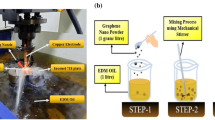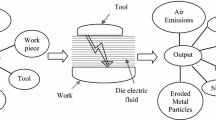Abstract
The current study performed modeling, analysis, and optimization of electrical discharge machining (EDM) under nano graphene mixed dielectric machining of Inconel 718 using ANFIS and a newly developed multi-objective seagull optimization algorithm. The influence of three major EDM controlling parameters namely peak current (Ip), pulse on time (Ton), and pulse off time (Toff) have been studied on the output machining characteristics viz. material removal rate (MRR) and cylindricity (CY) deviation for each of the experiments. In this work, EDM performance was enhanced by dispersing nano-graphene powder into EDM Oil as a dielectric medium and improvement from conventional EDM was analysed. The Taguchi L27 orthogonal array was utilized for planning and conducting EDM experiments, while analysis of variance (ANOVA) tests and regression analysis were conducted for examining the influence of input process variables on machining response variables. From results, it was realized that nano graphene mixed dielectric EDM improved the machining performance in comparison to traditional EDM performance. The modeling of response variables in terms of input process variables and optimal process conditions were determined using efficient intelligent methods namely ANFIS model and the newly developed multi-objective seagull optimization algorithm (MOSOA), respectively. It was found that nanographene mixed EDM improved MRR and cylindricity deviation by 13.88% and 25.76% respectively in comparison to conventional EDM without nanographene mixed dielectric. The MOSOA algorithm provides a number of non-dominated pareto solutions and best machining conditions among 32 optimal sets for nanographene mixed EDM was selected as a pulse on time of 12 µs, pulse off time as 7 µs, and peak current at 9 A. Finally, the scanning electron microscopy image also shows the improvement in surface finish of nano graphene mixed dielectric EDM in comparison to traditional EDM.

















Similar content being viewed by others
Abbreviations
- EDM:
-
Electrical discharge machining
- Ip:
-
Peak current
- Ton:
-
Pulse on time
- Toff:
-
Pulse off time
- MRR:
-
Material removal rate
- CL:
-
Cylindricity
- FESEM:
-
Field emission scanning electron microscope
- CMM:
-
Coordinate measuring machine
- ANOVA:
-
Analysis of variance
- S/N Ratio:
-
Signal to noise ratio
References
Ho K H and Newman S T 2003 State of the art electrical discharge machining (EDM). Int. J. Mach. Tools Manuf. 43(13): 1287–1300
Prakash V, Kumar P, Singh P K, Hussain M, Das A K and Chattopadhyaya S 2019 Micro-electrical discharge machining of difficult-to-machine materials: a review. Proc. Inst. Mech. Eng. Part B: J. Eng. Manuf. 233(2): 339–370
Chakraborty S, Bhattacharyya B and Diyaley S 2019 Applications of optimization techniques for parametric analysis of non-traditional machining processes: a review. Manag. Sci. Lett. 9(3): 467–494
Marashi H, Jafarlou D M, Sarhan A A and Hamdi M 2016 State of the art in powder mixed dielectric for EDM applications. Precis. Eng. 46: 11–33
Katz Z and Tibbles C J 2005 Analysis of micro-scale EDM process. Int. J. Adv. Manuf. Technol. 25(9–10): 923–928
Mandal A and Dixit A R 2014 State of art in wire electrical discharge machining process and performance. Int. J. Mach. Mach. Mater. 16(1): 1–21
Wang Z Y, Rajurkar K P, Fan J, Lei S, Shin Y C and Petrescu G 2003 Hybrid machining of Inconel 718. Int. J. Mach. Tools Manuf. 43(13): 1391–1396
Jahan M P, San Wong Y and Rahman M 2010 A comparative experimental investigation of deep-hole micro-EDM drilling capability for cemented carbide (WC-Co) against austenitic stainless steel (SUS 304). Int. J. Adv. Manuf. Technol. 46(9–12): 1145–1160
D’Urso G and Merla C 2014 Workpiece and electrode influence on micro-EDM drilling performance. Precis. Eng. 38(4): 903–914
Teimouri R and Baseri H 2014 Optimization of magnetic field assisted EDM using the continuous ACO algorithm. Appl. Soft Comput. 14: 381–389
Kibria G, Sarkar B R, Pradhan B B and Bhattacharyya B 2010 Comparative study of different dielectrics for micro-EDM performance during microhole machining of Ti-6Al-4V alloy. Int. J. Adv. Manuf. Technol. 48(5–8): 557–570
Dwivedi A P and Choudhury S K 2016 Effect of tool rotation on MRR, TWR, and surface integrity of AISI-D3 steel using the rotary EDM process. Mater. Manuf. Process. 31(14): 1844–1852
Khatri B C, Rathod P and Valaki J B 2016 Ultrasonic vibration–assisted electric discharge machining: A research review. Proc. Inst. Mech. Eng. Part B: J. Eng. Manuf. 230(2): 319–330
Sabyrov N, Jahan M P, Bilal A and Perveen A 2019 Ultrasonic vibration assisted electro-discharge machining (edm)—An overview. Materials 12(3): 522
Singh J and Sharma R K 2016 Assessing the effects of different dielectrics on environmentally conscious powder-mixed EDM of difficult-to-machine material (WC-Co). Front. Mech. Eng. 11(4): 374–387
Teimouri R and Baseri H 2012 Effects of magnetic field and rotary tool on EDM performance. J. Manuf. Process. 14(3): 316–322
Singh Bains P, Sidhu S S and Payal H S 2018 Investigation of magnetic field-assisted EDM of composites. Mater. Manuf. Process. 33(6): 670–675
Tzeng Y F and Lee C Y 2001 Effects of powder characteristics on electrodischarge machining efficiency. Int. J. Adv. Manuf. Technol. 17(8): 586–592
Kozak J, Rozenek M and Dabrowski L 2003 Study of electrical discharge machining using powder-suspended working media. Proc. Inst. Mech. Eng. Part B: J. Eng. Manuf. 217(11): 1597–1602
Yadav L, Lal S, Singh N K, Chouhan D S and Singh Y 2020 Impact of powder additives in liquid and gaseous dielectric fluids on electrical discharge machining through aerospace region applications-A review. Mater. Today: Proc. 25: 952–960
Mohanty S and Routara B C 2016 A review on machining of metal matrix composites using nanoparticle mixed dielectric in electro-discharge machining. Int. J. Automot. Mech. Eng. 13(2): 3518–3539
Surekha B, Sree Lakshmi T, Jena H and Samal P 2019 Response surface modelling and application of fuzzy grey relational analysis to optimise the multi response characteristics of EN-19 machined using powder mixed EDM. Aust. J. Mech. Eng. 19(1): 19–29
Paswan K, Pramanik A and Chattopadhyaya S 2020 Machining performance of Inconel 718 using graphene nanofluid in EDM. Mater. Manuf. Process. 35(1): 33–42
Baseri H and Sadeghian S 2016 Effects of nanopowder TiO 2-mixed dielectric and rotary tool on EDM. Int. J. Adv. Manuf. Technol. 83(1–4): 519–528
Kumar A, Maheshwari S, Sharma C and Beri N 2010 A study of multiobjective parametric optimization of silicon abrasive mixed electrical discharge machining of tool steel. Mater. Manuf. Process. 25(10): 1041–1047
Sivaprakasam P, Hariharan P and Gowri S 2019 Experimental investigations on nano powder mixed Micro-Wire EDM process of inconel-718 alloy. Measurement 147: 106844
Kumar A, Mandal A, Dixit A R and Das A K 2018 Performance evaluation of Al2O3 nano powder mixed dielectric for electric discharge machining of Inconel 825. Mater. Manuf. Process. 33(9): 986–995
Sari M M, Noordin M Y and Brusa E 2013 Role of multi-wall carbon nanotubes on the main parameters of the electrical discharge machining (EDM) process. Int. J. Adv. Manuf. Technol. 68(5): 1095–1102
Yeo S H, Tan P C and Kurnia W 2007 Effects of powder additives suspended in dielectric on crater characteristics for micro electrical discharge machining. J. Micromech. Microeng. 17(11): N91
Prihandana G S, Sriani T, Mahardika M, Hamdi M, Miki N, Wong Y S and Mitsui K 2014 Application of powder suspended in dielectric fluid for fine finish micro-EDM of Inconel 718. Int. J. Adv. Manuf. Technol. 75(1–4): 599–613
Tiwary A P, Pradhan B B and Bhattacharyya B 2019 Influence of various metal powder mixed dielectric on micro-EDM characteristics of Ti-6Al-4V. Mater. Manuf. Process. 34(10): 1103–1119
HuuPhan N, Muthuramalingam T, Vu N N and Tuan N Q 2020 Influence of micro size titanium powder-mixed dielectric medium on surface quality measures in EDM process. Int. J. Adv. Manuf. Technol. 109(3): 797–807
Prabhu S, Uma M and Vinayagam B K 2013 Adaptive neuro-fuzzy interference system modelling of carbon nanotube-based electrical discharge machining process. J. Braz. Soc. Mech. Sci. Eng. 35(4): 505–516
Cogun C, Özerkan B and Karacay T 2006 An experimental investigation on the effect of powder mixed dielectric on machining performance in electric discharge machining. Proc. Inst. Mech. Eng. Part B: J. Eng. Manuf. 220(7): 1035–1050
Abhilash P M and Chakradhar D 2020 Prediction and analysis of process failures by ANN classification during wire-EDM of Inconel 718. Adv. Manuf. 8(4): 519–536
Jafarian F 2020 Electro discharge machining of Inconel 718 alloy and process optimization. Mater. Manuf. Process. 35(1): 95–103
Sengottuvel P, Satishkumar S and Dinakaran D 2013 Optimization of multiple characteristics of EDM parameters based on desirability approach and fuzzy modeling. Procedia Eng. 64: 1069–1078
Ashok R, Poovazhagan L, Srinath Ramkumar S and Vignesh Kumar S 2017 Optimization of material removal rate in wire-EDM using fuzzy logic and artifical neural network. Appl. Mech. Mater. 867: 73–80
Dhanabalan S, Sivakumar K and Narayanan C S 2013 Optimization of machining parameters of EDM while machining Inconel 718 for form tolerance and orientation tolerance. Indian J. Eng. Mater. Sci. 20(5): 391–397
Kumar S and Dhanabalan S 2019 Influence on machinability and form tolerance of Inconel 718 in Edm using different diameter multi hole Cu electrodes. SN Appl. Sci. 1(5): 396
Senthilkumar T S and Muralikannan R 2019 Enhancing the geometric tolerance of aluminium hybrid metal matrix composite using EDM process. J. Braz. Soc. Mech. Sci. Eng. 41(1): 41
Bhaumik M and Maity K 2019 Effect of electrode materials on different EDM aspects of titanium alloy. Silicon 11(1): 187–196
Sandhya M, Ramasamy D, Sudhakar K, Kadirgama K, Samykano M, Harun W S W, Nazafi G, Mofijur M and Mazlan M 2021 A systematic review on graphene-based nanofluids application in renewable energy systems: Preparation, characterization, and thermophysical properties. Sustain. Energy Technol. Assess. 44: 101058
Pathak V K and Singh R 2021 A comprehensive review on computational techniques for form error evaluation. Arch. Comput. Methods Eng. 29: 1199–1228
Jang J S 1993 ANFIS: adaptive-network-based fuzzy inference system. IEEE Trans. Syst. Man Cybern. 23(3): 665–685
Dhiman G, Singh K K, Soni M, Nagar A, Dehghani M, Slowik A, Kaur A, Sharma A, Houssein E H and Cengiz K 2021 MOSOA: a new multi-objective seagull optimization algorithm. Expert Syst. Appl. 167: 114150
Dhiman G and Kumar V 2019 Seagull optimization algorithm: Theory and its applications for large-scale industrial engineering problems. Knowl.-Based Syst. 165: 169–196
Acknowledgements
The authors would like to express their sincere gratitude towards the School of Automobile, Mechanical and Mechatronics (SAMM) Engineering, Manipal University Jaipur for extending their support by providing machining and results testing equipment to carry out this research successfully. Furthermore, we would like to acknowledge BSDU Jaipur for providing Coordinate Measuring Machine (CMM) to analyse the form tolerance i.e., Cylindricity.
Author information
Authors and Affiliations
Corresponding author
Ethics declarations
Conflict of interest
The authors declare that they have no conflict of interest. All co-authors have seen and agree with the contents of the manuscript and there is no financial interest to report.
Rights and permissions
About this article
Cite this article
Goyal, A., Sharma, D., Bhowmick, A. et al. Multi-objective optimization and characterization of cylindricity and material removal rate in nanographene mixed dielectric EDM using ANFIS and MOSOA. Sādhanā 47, 139 (2022). https://doi.org/10.1007/s12046-022-01914-2
Received:
Revised:
Accepted:
Published:
DOI: https://doi.org/10.1007/s12046-022-01914-2




